

Bearded Pig
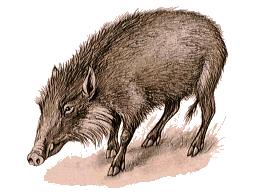
Scientific Name: Sus barbatus
Size: body: 11.6-1.8 m, tail: 20-30 cm
Habitat: rainforest, scrub, mangrove swamps
Conservation Status: Non-threatened
¡@
¡@

 A large pig with an elongate head and a narrow body, the bearded pig has abundant whiskers on its chin and a bristly, wartlike protuberance
beneath each eye. These warts are more conspicuous in males than in females. Fallen fruit, roots, shoots and insect larvae are the bearded pig's staple
foods, and it also invades fields of root crops. It often follows gibbons and macaques to pick up the fruit they drop. After a gestation of about 4 months,
the female makes a nest of plant material and gives birth to 2 or 3 young, which stay with her for about a year.
A large pig with an elongate head and a narrow body, the bearded pig has abundant whiskers on its chin and a bristly, wartlike protuberance
beneath each eye. These warts are more conspicuous in males than in females. Fallen fruit, roots, shoots and insect larvae are the bearded pig's staple
foods, and it also invades fields of root crops. It often follows gibbons and macaques to pick up the fruit they drop. After a gestation of about 4 months,
the female makes a nest of plant material and gives birth to 2 or 3 young, which stay with her for about a year.
Brazilian Tapir

Scientific Name: Tapirus terrestris
Size: body: 2m, tail: 5-8 cm
Habitat: rainforest, near water or swamps
Conservation Status: Non-threatened
¡@
¡@
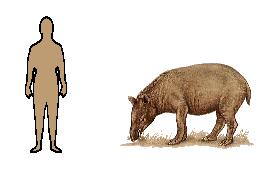
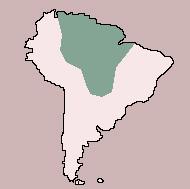 Nearly always found near water, the Brazilian tapir is a good swimmer and diver but also moves fast on land, even over rugged, mountainous country.
It is dark brown in color and has a low, erect mane running from the crown down the back of the neck. Using its mobile snout, this tapir feeds on leaves,
buds, shoots and small branches that it tears from trees, fruit, grasses and aquatic plants. The female gives birth to a single spotted and striped young
after a gestation of 390 to 400 days.
Nearly always found near water, the Brazilian tapir is a good swimmer and diver but also moves fast on land, even over rugged, mountainous country.
It is dark brown in color and has a low, erect mane running from the crown down the back of the neck. Using its mobile snout, this tapir feeds on leaves,
buds, shoots and small branches that it tears from trees, fruit, grasses and aquatic plants. The female gives birth to a single spotted and striped young
after a gestation of 390 to 400 days.
Capybara
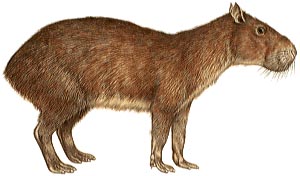
Scientific Name: Hydrochoerus hydrochaeris
Size: body: 1-1.3 m, tail: vestigial
Habitat: forest, near water
Conservation Status: Non-threatened
¡@
¡@
 The capybara spends much time in water and is an excellent swimmer and diver; it has
partial webs between the digits of both its hind feet and forefeet. When
swimming, only its eyes, ears and nostrils show above the water. Capybaras feed
on plant material, including aquatic plants, and their cheek teeth grow
throughout life to counteract the wear and tear of chewing. They live in family
groups and are active at dawn and dusk. In areas where they are frequently
disturbed, capybaras may be nocturnal. Males and females look alike, but there
is a scent gland on the nose that is larger in the male. They mate in spring,
and a litter of 2 young is born after a gestation of 15 to 18 weeks. The young
are well developed at birth.
The capybara spends much time in water and is an excellent swimmer and diver; it has
partial webs between the digits of both its hind feet and forefeet. When
swimming, only its eyes, ears and nostrils show above the water. Capybaras feed
on plant material, including aquatic plants, and their cheek teeth grow
throughout life to counteract the wear and tear of chewing. They live in family
groups and are active at dawn and dusk. In areas where they are frequently
disturbed, capybaras may be nocturnal. Males and females look alike, but there
is a scent gland on the nose that is larger in the male. They mate in spring,
and a litter of 2 young is born after a gestation of 15 to 18 weeks. The young
are well developed at birth.
Chimpanzee
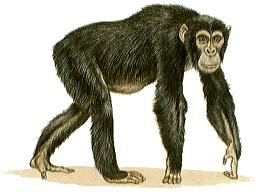
Scientific Name: Pan troglodytes
Size: body: 68-94 cm, tail: absent, height: 1.2 - 1.7 m
Habitat: rainforest, savanna with woodland
Conservation Status: Vulnerable
The intelligent, social chimpanzee has a wide
range of sounds and gestures for communication and is probably one of the most
expressive of all animals. Thickset and robust, but more lightly built than the
gorilla, the chimpanzee has a strong body and long limbs, the powerful arms
being longer than the legs. Its hands and feet are narrow and long, with
opposable thumbs on the hands.  Males are slightly larger than females. There is great variability in the color
of hair and facial skin, but the hair is generally blackish and the face light,
darkening in older individuals. The rounded head bears broad, prominent ears,
and the lips are mobile and protrusible. Chimpanzees climb well but spend most
of the time on the ground, where they generally walk on all fours, even though
they stand erect on occasion, as when their hands are full of food. Their social
structure is more variable than that of the gorilla. Rainforest animals live in
troops of males, of females with young, of males and females with young, or of
adults of both sexes without young. The composition of the troop often changes.
Savanna chimpanzees generally live in more stable troops of 1 or more males,
several females and their young. They occupy a home range, the size of which
depends on the size of the troop and on the food supply. Neighboring troops meet
with much noise and communication, but there is usually little aggression.
Males are slightly larger than females. There is great variability in the color
of hair and facial skin, but the hair is generally blackish and the face light,
darkening in older individuals. The rounded head bears broad, prominent ears,
and the lips are mobile and protrusible. Chimpanzees climb well but spend most
of the time on the ground, where they generally walk on all fours, even though
they stand erect on occasion, as when their hands are full of food. Their social
structure is more variable than that of the gorilla. Rainforest animals live in
troops of males, of females with young, of males and females with young, or of
adults of both sexes without young. The composition of the troop often changes.
Savanna chimpanzees generally live in more stable troops of 1 or more males,
several females and their young. They occupy a home range, the size of which
depends on the size of the troop and on the food supply. Neighboring troops meet
with much noise and communication, but there is usually little aggression. 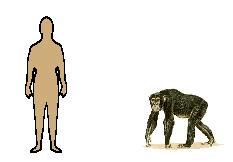 Active in the daytime, chimpanzees rise at dawn and feed mainly on plant
material, such as fruit, nuts, leaves, shoots and bark, and on eggs and insects.
They will use stems or twigs as tools, to extract termites or ants from their
hiding places. Savanna chimpanzees will kill young animals for food by holding
them by the hind limbs and striking their heads on the ground. At night,
chimpanzees usually sleep in the trees, each making its own nest with
interwoven, broken and bent branches. Young under 3 years old sleep with their
mothers. Females have regular periods of heat, with swelling of the genital
region, and may mate with all the males in the troop. Usually 1 young is born,
sometimes twins, after a gestation of 227 to 232 days. The young animal lives
closely with its mother for 2 to 3 years.
Active in the daytime, chimpanzees rise at dawn and feed mainly on plant
material, such as fruit, nuts, leaves, shoots and bark, and on eggs and insects.
They will use stems or twigs as tools, to extract termites or ants from their
hiding places. Savanna chimpanzees will kill young animals for food by holding
them by the hind limbs and striking their heads on the ground. At night,
chimpanzees usually sleep in the trees, each making its own nest with
interwoven, broken and bent branches. Young under 3 years old sleep with their
mothers. Females have regular periods of heat, with swelling of the genital
region, and may mate with all the males in the troop. Usually 1 young is born,
sometimes twins, after a gestation of 227 to 232 days. The young animal lives
closely with its mother for 2 to 3 years.
Gorilla

Scientific Name: Gorilla gorilla
Size: body: Male height: 1.7-1.8 m, Female height: 1.4-1.5 m, tail: absent
Habitat: rainforest up to 3,000 m
Conservation Status: Vulnerable
The largest and most robust of the primates,
the gorilla is also a gentle, intelligent and sociable animal which lives a
peaceful, quiet existence if undisturbed. Its body, covered with coarse black
hair, is massive, with a short, broad trunk and wide chest and shoulders. The
head is large, with a short muzzle, and the eyes and ears small; old males have
high crowns. 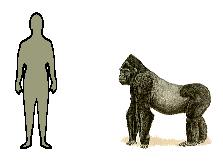 The muscular arms are longer than the short, thick legs, and the broad hands are
equipped with short fingers and thumbs. Males are bigger and heavier than
females, and those over 10 years old have silvery-gray hair on their backs --
hence the name silverback, given to old males. There are two races: the lowland
and the mountain gorilla, also referred to as the western and eastern races,
respectively. On the ground, gorillas normally move in a stooped posture, with
the knuckles of the hands resting on the ground, but they do stand erect on
occasion. Females and juveniles climb trees, but males rarely do so because of
their great bulk. Gorillas live in a close-knit group of a dominant male, 1 or 2
other males, several females and young; some groups may contain only the
dominant male, 2 or 3 females and young. The group wanders in a home range of 10
to 40 sq km (4 to 15 1/2 sq mi), which is not defended or marked at the
boundaries. There may be some conflict with neighboring groups, but encounters
are generally avoided by communications such as drumming on the ground from a
distance.
The muscular arms are longer than the short, thick legs, and the broad hands are
equipped with short fingers and thumbs. Males are bigger and heavier than
females, and those over 10 years old have silvery-gray hair on their backs --
hence the name silverback, given to old males. There are two races: the lowland
and the mountain gorilla, also referred to as the western and eastern races,
respectively. On the ground, gorillas normally move in a stooped posture, with
the knuckles of the hands resting on the ground, but they do stand erect on
occasion. Females and juveniles climb trees, but males rarely do so because of
their great bulk. Gorillas live in a close-knit group of a dominant male, 1 or 2
other males, several females and young; some groups may contain only the
dominant male, 2 or 3 females and young. The group wanders in a home range of 10
to 40 sq km (4 to 15 1/2 sq mi), which is not defended or marked at the
boundaries. There may be some conflict with neighboring groups, but encounters
are generally avoided by communications such as drumming on the ground from a
distance. 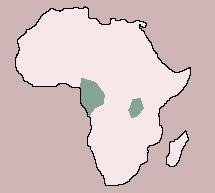 Old males will threaten rivals by standing erect and beating the chest while
roaring and barking and sometimes by tearing up and throwing plants. When the
leader of a troop dies, younger males contest for dominance. Gorillas are active
in the daytime. The troop rises between 6 A.M. and 8 A.M., feeds for a while on
plant material, such as leaves, buds, stalks, berries, bark and ferns, and then
has a period of rest and relaxation. Gorillas do not appear to drink but get the
water they need from their juicy diet. They feed again in the afternoon and then
retire for the night in nests made of twigs and leaves. Young gorillas under 3
years old sleep with their mothers, but all others have their own nests.
Breeding appears to take place at any time of year. The female gives birth to a
single young after a gestation of more than 9 months. The young is completely
dependent and clings to its mother's fur at first, but it is able to sit up at 3
months and to walk and climb at 5 months. It suckles for 12 to 18 months and
remains with its mother for about 3 years.
Old males will threaten rivals by standing erect and beating the chest while
roaring and barking and sometimes by tearing up and throwing plants. When the
leader of a troop dies, younger males contest for dominance. Gorillas are active
in the daytime. The troop rises between 6 A.M. and 8 A.M., feeds for a while on
plant material, such as leaves, buds, stalks, berries, bark and ferns, and then
has a period of rest and relaxation. Gorillas do not appear to drink but get the
water they need from their juicy diet. They feed again in the afternoon and then
retire for the night in nests made of twigs and leaves. Young gorillas under 3
years old sleep with their mothers, but all others have their own nests.
Breeding appears to take place at any time of year. The female gives birth to a
single young after a gestation of more than 9 months. The young is completely
dependent and clings to its mother's fur at first, but it is able to sit up at 3
months and to walk and climb at 5 months. It suckles for 12 to 18 months and
remains with its mother for about 3 years.
Okapi
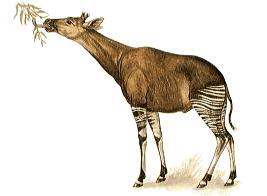
Scientific Name: Okapia johnstoni
Size: body: 1.2-2 m, tail: 30-42 cm
Habitat: rainforest
Conservation Status: Non-threatened
¡@
¡@
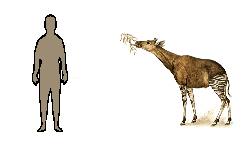 A inhabitant of dense forest, the okapi, although long hunted by the local Pygmy
tribes, was only made known to the outside world in 1901, when it was discovered
by the then governor of Uganda. He thought it was related to the zebra because
of its stripes, but, in fact, it bears a remarkable resemblance to primitive
ancestors of the giraffe, known only from fossils. The okapi has a compact body,
which slopes down toward the hindquarters, and distinctive stripes on its legs.
A inhabitant of dense forest, the okapi, although long hunted by the local Pygmy
tribes, was only made known to the outside world in 1901, when it was discovered
by the then governor of Uganda. He thought it was related to the zebra because
of its stripes, but, in fact, it bears a remarkable resemblance to primitive
ancestors of the giraffe, known only from fossils. The okapi has a compact body,
which slopes down toward the hindquarters, and distinctive stripes on its legs.
 Only males possess short, skin-covered horns, similar to those of the giraffe.
The tongue is so long that the okapi can use it to clean its own eyes and
eyelids. Okapis live alone, each in its own home range, and meet only in the
breeding season. They feed on leaves, buds and shoots of trees, which they can
reach with their long tongues, and on grass, ferns, fruit, fungi and manioc.
Pairing usually takes place between May and June or November and December but
may occur at any time. The female gives birth to 1 young after a gestation of
421 to 457 days. The young okapi suckles for up to 10 months and is not fully
developed until 4 or 5 years of age.
Only males possess short, skin-covered horns, similar to those of the giraffe.
The tongue is so long that the okapi can use it to clean its own eyes and
eyelids. Okapis live alone, each in its own home range, and meet only in the
breeding season. They feed on leaves, buds and shoots of trees, which they can
reach with their long tongues, and on grass, ferns, fruit, fungi and manioc.
Pairing usually takes place between May and June or November and December but
may occur at any time. The female gives birth to 1 young after a gestation of
421 to 457 days. The young okapi suckles for up to 10 months and is not fully
developed until 4 or 5 years of age.
Orangutan
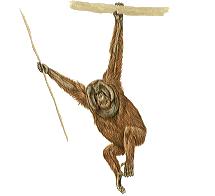
Scientific Name: Pongo pygmaeus
Size: body: 1.2-1.5 m, tail: absent
Habitat: rainforest
Conservation Status: Endangered
¡@
¡@
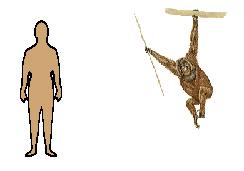 The orangutan, with its reddish-brown, shaggy
hair, has a strong, heavily built body and is the second-largest primate. The
arms are long and powerful and reach to the ankles when the animal stands erect;
there is a small thumb on each broad hand that is opposable to the first digit.
The orangutan's legs are relatively short and weaker than the arms. Males are
much larger and heavier than females and are also identified by the cheek flaps
that surround the face of the mature adult. All adults have fatty throat
pouches. Orangutans live alone, in pairs or in small family groups and are
active in the daytime at all levels of the trees. They walk along large branches
on all fours or erect and sometimes swing by their
The orangutan, with its reddish-brown, shaggy
hair, has a strong, heavily built body and is the second-largest primate. The
arms are long and powerful and reach to the ankles when the animal stands erect;
there is a small thumb on each broad hand that is opposable to the first digit.
The orangutan's legs are relatively short and weaker than the arms. Males are
much larger and heavier than females and are also identified by the cheek flaps
that surround the face of the mature adult. All adults have fatty throat
pouches. Orangutans live alone, in pairs or in small family groups and are
active in the daytime at all levels of the trees. They walk along large branches
on all fours or erect and sometimes swing by their
 hands from branch to branch.
On the ground, they walk on all fours or stand erect. Fruit is their staple
diet, but they also feed on leaves, seeds, young birds and eggs. The orangutan sleeps in the trees in a platform nest made of sticks; it may make
a new nest every night. After a gestation period of more than 9 months, the
female gives birth to a single young. She cares for her offspring for some time
-- one captive young was suckled for 6 years -- and it clings to her fur as she
moves around in the trees.
hands from branch to branch.
On the ground, they walk on all fours or stand erect. Fruit is their staple
diet, but they also feed on leaves, seeds, young birds and eggs. The orangutan sleeps in the trees in a platform nest made of sticks; it may make
a new nest every night. After a gestation period of more than 9 months, the
female gives birth to a single young. She cares for her offspring for some time
-- one captive young was suckled for 6 years -- and it clings to her fur as she
moves around in the trees.
Salano
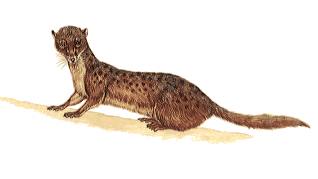
Scientific Name: Salanoia concolor
Size: body: 35-38 cm, tail: 18-20 cm
Habitat: rainforest
Conservation Status: Non-threatened
¡@
¡@
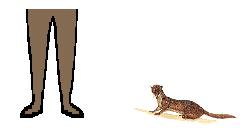 Salanos are gregarious animals; they pair for life and live in family groups in a
territory, marking the boundaries with secretions of the anal glands. At
Salanos are gregarious animals; they pair for life and live in family groups in a
territory, marking the boundaries with secretions of the anal glands. At  night,
the salano rests in a burrow that it digs or takes over from other animals or in
a hollow tree. During the day, it searches for insects (its main food),
amphibians, reptiles and, occasionally, small mammals and birds. It also eats
the contents of eggs, which it cracks by taking them in its hind feet and
hurling them backward against a stone or tree. The female gives birth to 1
young, but other details of the salano's breeding habits are not known.
night,
the salano rests in a burrow that it digs or takes over from other animals or in
a hollow tree. During the day, it searches for insects (its main food),
amphibians, reptiles and, occasionally, small mammals and birds. It also eats
the contents of eggs, which it cracks by taking them in its hind feet and
hurling them backward against a stone or tree. The female gives birth to 1
young, but other details of the salano's breeding habits are not known.
Slow Loris
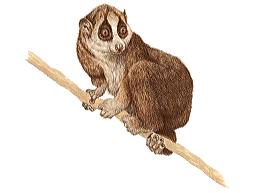
Scientific Name: Nycticebus coucang
Size: body: 26-38 cm, tail: vestigial
Habitat: dense rainforest
Conservation Status: Non-threatened
¡@
¡@
 A plumper, shorter-limbed animal than its relative the slender loris, the slow
loris is,
A plumper, shorter-limbed animal than its relative the slender loris, the slow
loris is, 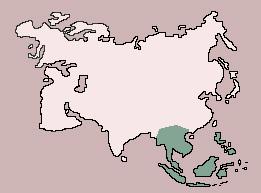 however, similar in its habits. It spends the day sleeping up in a
tree, its body rolled into a tight ball. At night, it feeds in the trees on
insects, bird's eggs, small birds and shoots and fruit, seldom coming down to
the ground. A slow, but accomplished, climber, its hands and feet are strong and
capable of grasping tightly. It can even hang by its feet. The thumb and great
toe are opposable to the other digits. Breeding takes place at any time of year,
and 1 young, sometimes 2, is born after a gestation of 193 days. Slow lorises
are thought to live in family groups.
however, similar in its habits. It spends the day sleeping up in a
tree, its body rolled into a tight ball. At night, it feeds in the trees on
insects, bird's eggs, small birds and shoots and fruit, seldom coming down to
the ground. A slow, but accomplished, climber, its hands and feet are strong and
capable of grasping tightly. It can even hang by its feet. The thumb and great
toe are opposable to the other digits. Breeding takes place at any time of year,
and 1 young, sometimes 2, is born after a gestation of 193 days. Slow lorises
are thought to live in family groups.
Spider Monkey
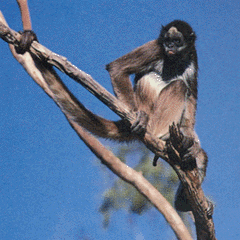
 Spider monkeys are the most acrobatic of the South American monkeys. They spend most of their time in the forest
canopy. They are large in size and have a powerful, well-developed prehensile tail that can
be used as a ¡§hook¡¨ for hanging from branches, or as a ¡§hand¡¨ for gathering and holding their favorite foods. Adult monkeys grow to be almost two
feet tall excluding the tail. Spider monkeys like to hang upside-down with all four
limbs and the tail holding on to branches which makes them look like a
spider and thus their name. They also have the ability to swing from
branch to branch at a high speed. Their fur color can be black, brown,
golden, red, or tan. Spider monkeys spend most of their time high up in the canopy where
they can find fruits and seeds to eat. They
Spider monkeys are the most acrobatic of the South American monkeys. They spend most of their time in the forest
canopy. They are large in size and have a powerful, well-developed prehensile tail that can
be used as a ¡§hook¡¨ for hanging from branches, or as a ¡§hand¡¨ for gathering and holding their favorite foods. Adult monkeys grow to be almost two
feet tall excluding the tail. Spider monkeys like to hang upside-down with all four
limbs and the tail holding on to branches which makes them look like a
spider and thus their name. They also have the ability to swing from
branch to branch at a high speed. Their fur color can be black, brown,
golden, red, or tan. Spider monkeys spend most of their time high up in the canopy where
they can find fruits and seeds to eat. They
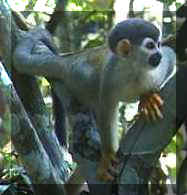 prefer to eat fruits, along with nuts, shoots,
buds, new leaves and flowers. When eating fruits, a family of spider monkeys
drops many to the ground, where they are eaten by agoutis, which destroy many of
the seeds. The monkeys, however, swallow the seeds along with the fruit, then carry them
away and deposit them in their dung elsewhere in the forest. Thus, the monkeys
are another species that aids the re-growth of the forest.
They are unusual monkeys in that they have only four fingers and no thumb. Their
high habitat protects them from most forest predators. They may be eaten by cats
and large snakes like boa constrictors; young monkeys are also preyed upon by
Harpy eagles. Spider monkeys are heavily hunted and are in danger of becoming extinct.
prefer to eat fruits, along with nuts, shoots,
buds, new leaves and flowers. When eating fruits, a family of spider monkeys
drops many to the ground, where they are eaten by agoutis, which destroy many of
the seeds. The monkeys, however, swallow the seeds along with the fruit, then carry them
away and deposit them in their dung elsewhere in the forest. Thus, the monkeys
are another species that aids the re-growth of the forest.
They are unusual monkeys in that they have only four fingers and no thumb. Their
high habitat protects them from most forest predators. They may be eaten by cats
and large snakes like boa constrictors; young monkeys are also preyed upon by
Harpy eagles. Spider monkeys are heavily hunted and are in danger of becoming extinct.
Sloth
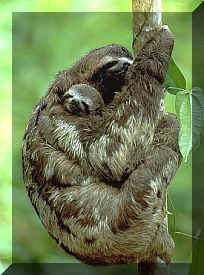
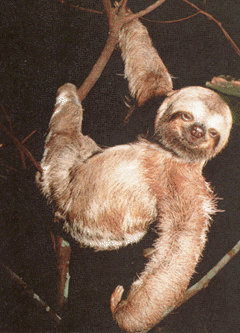 Sloths are extremely slow-moving mammals found in the rainforest of Central and South America. There are two species of
sloths:two-toed and three-toed. Most sloths are about the size of a small dog and they have short, flat flat heads. They
often live for up to 30 years. The sloth is almost totally arboreal (¡§tree-dwelling¡¨), with a
body "built to hang." It lives in the shrub or lower tree layer, but
sometimes moves to the canopy. Its long, coarse, grayish-brown fur often appears
greenish, not due to pigment but to algae growing on it. The sloth¡¦s greenish
color and its sluggish habits provide an effective camouflage: hanging quietly,
the sloth resembles a bundle of leaves. Large curved claws help the sloth to
keep a strong grip on tree branches. Considered by some to be a highly selective feeder, it
was once thought to eat only leaves of the cecropia tree. Although cecropia
leaves do make up the bulk of the sloth¡¦s diet, more recent studies have shown
that it also eats the leaves of many other tree species. The three-toed sloth spends nearly its entire life
sleeping, feeding and moving around in trees, only descending to the base of the
trunk every week or two to deposit dung pellets. It expends a lot of energy in
this effort, descending from the tree, poking a hole with its stubby tail and
then carefully burying its dung pellets. This ¡§toilet¡¨ schedule helps this
tree-dweller to conserve water, which, ironically, is not easy to get up in the
trees. The sloth sleeps soundly upside down, curled up
with their head placed between the arms and the feet drawn close
together for about 18 hours each day. Mothers also give birth to babies upside-down. Babies cling
to their mothers until they are able to take care of themselves. It is
protected by its high habitat and hanging posture from most predators like
the jaguar. However, it is vulnerable to attacks by the Harpy eagle, especially when it basks in the
sun at the end of branches. Though rarely seen, the sloth is probably one of the
most common large animals in the New World tropics; however, populations are
declining due to destruction of forest habitat.
Sloths are extremely slow-moving mammals found in the rainforest of Central and South America. There are two species of
sloths:two-toed and three-toed. Most sloths are about the size of a small dog and they have short, flat flat heads. They
often live for up to 30 years. The sloth is almost totally arboreal (¡§tree-dwelling¡¨), with a
body "built to hang." It lives in the shrub or lower tree layer, but
sometimes moves to the canopy. Its long, coarse, grayish-brown fur often appears
greenish, not due to pigment but to algae growing on it. The sloth¡¦s greenish
color and its sluggish habits provide an effective camouflage: hanging quietly,
the sloth resembles a bundle of leaves. Large curved claws help the sloth to
keep a strong grip on tree branches. Considered by some to be a highly selective feeder, it
was once thought to eat only leaves of the cecropia tree. Although cecropia
leaves do make up the bulk of the sloth¡¦s diet, more recent studies have shown
that it also eats the leaves of many other tree species. The three-toed sloth spends nearly its entire life
sleeping, feeding and moving around in trees, only descending to the base of the
trunk every week or two to deposit dung pellets. It expends a lot of energy in
this effort, descending from the tree, poking a hole with its stubby tail and
then carefully burying its dung pellets. This ¡§toilet¡¨ schedule helps this
tree-dweller to conserve water, which, ironically, is not easy to get up in the
trees. The sloth sleeps soundly upside down, curled up
with their head placed between the arms and the feet drawn close
together for about 18 hours each day. Mothers also give birth to babies upside-down. Babies cling
to their mothers until they are able to take care of themselves. It is
protected by its high habitat and hanging posture from most predators like
the jaguar. However, it is vulnerable to attacks by the Harpy eagle, especially when it basks in the
sun at the end of branches. Though rarely seen, the sloth is probably one of the
most common large animals in the New World tropics; however, populations are
declining due to destruction of forest habitat.
Vampire bats
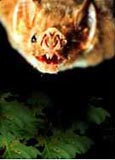 Vampire bats are medium sized bats that pierce the skin of their victim, usually a cow or pig,
with razor sharp teeth. The victim is unaware of the cut because the bat's
saliva contains an effective anesthetic, as well as an anti-coagulant, to
keep the blood flowing while the bat feeds. Blood is the sole form of food
for this bat.
Vampire bats are medium sized bats that pierce the skin of their victim, usually a cow or pig,
with razor sharp teeth. The victim is unaware of the cut because the bat's
saliva contains an effective anesthetic, as well as an anti-coagulant, to
keep the blood flowing while the bat feeds. Blood is the sole form of food
for this bat.
Jaguar

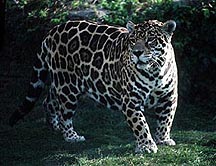 Although it is the third largest cat in the world and the largest predator in the
Amazon, the jaguar is increasingly uncommon and rarely seen. It can be found in
many habitats, but prefers riverbanks, where it usually sleeps by day and hunts
by dusk or night. The jaguar generally hunts forest floor animals, but
can both climb and swim with ease. Its favorite hunting strategy is to lie in
wait in branches and pounce on its victim. Jaguars are ¡§searchers,¡¨ preying
on whatever creatures they come upon, unlike ¡§pursuers¡¨ such as the cheetah,
who chase down only a few select animals. The jaguar¡¦s major prey includes
tapirs, deer, monkeys, and capybara, but it will eat almost any vertebrate.
Occasionally, it is able to catch sloths when they make one of their infrequent
descents to the forest floor. The heavy jaws and large facial muscles of the
jaguar give it one of the most powerful bites of any cat. The most water-loving
of the cats, they can cross wide rivers and capture prey in the water. It can
eat "tough" prey like caiman and turtles, crunching through the shell.
Jaguars are "keystone" predators that help keep populations of
prolific rodents like agoutis in balance. ¡§Keystone¡¨ species are critically
important to others in the community. Their removal causes dramatic changes for
other species, altering the balance in the community. Jaguars have distinctive spots. In the rainforest, this
serves as an advantage. The spotted pattern moving through the sun-flecked light
and alternating shadow becomes less of an obvious physical outline, thereby
disguising the jaguar as it stealthily moves across the forest floor. Jaguars
are normally solitary. Still widely distributed in South America, but persecuted
as predators by cattle ranchers, they have become extinct or endangered in many
local areas.
Although it is the third largest cat in the world and the largest predator in the
Amazon, the jaguar is increasingly uncommon and rarely seen. It can be found in
many habitats, but prefers riverbanks, where it usually sleeps by day and hunts
by dusk or night. The jaguar generally hunts forest floor animals, but
can both climb and swim with ease. Its favorite hunting strategy is to lie in
wait in branches and pounce on its victim. Jaguars are ¡§searchers,¡¨ preying
on whatever creatures they come upon, unlike ¡§pursuers¡¨ such as the cheetah,
who chase down only a few select animals. The jaguar¡¦s major prey includes
tapirs, deer, monkeys, and capybara, but it will eat almost any vertebrate.
Occasionally, it is able to catch sloths when they make one of their infrequent
descents to the forest floor. The heavy jaws and large facial muscles of the
jaguar give it one of the most powerful bites of any cat. The most water-loving
of the cats, they can cross wide rivers and capture prey in the water. It can
eat "tough" prey like caiman and turtles, crunching through the shell.
Jaguars are "keystone" predators that help keep populations of
prolific rodents like agoutis in balance. ¡§Keystone¡¨ species are critically
important to others in the community. Their removal causes dramatic changes for
other species, altering the balance in the community. Jaguars have distinctive spots. In the rainforest, this
serves as an advantage. The spotted pattern moving through the sun-flecked light
and alternating shadow becomes less of an obvious physical outline, thereby
disguising the jaguar as it stealthily moves across the forest floor. Jaguars
are normally solitary. Still widely distributed in South America, but persecuted
as predators by cattle ranchers, they have become extinct or endangered in many
local areas.
Agouti

 The agouti, a relatively large, rabbit-sized rodent with a short tail and long
legs, is mainly active during the day, but at times is also active at dusk and
at night. It lives on the forest floor and sleeps in burrows. Many rodents destroy all the seeds that they gather and
eat, but agoutis exhibit the behavior of ¡§scatter-hoarding¡¨; they carry some
seeds long distances and bury them without damage, just as squirrels in North
America bury acorns. Fruits too heavy or awkward to be carried by bats or
monkeys are often dispersed by animals like agoutis.
For example, people have wondered how the seeds of the Brazil nut tree are freed
from the very hard woody fruit enclosing them. It is now known that Brazil nut
fruits, after falling to the ground, are chiseled open by agoutis, which eat
some of the seeds but scatter-hoard the rest. Agoutis generally fail to find all
of the Brazil nut seeds they bury, and these are then free to germinate and grow
into seedlings. Agoutis are eaten by predators of the forest floor like
the jaguar, large snakes, and bush dogs. They can also be taken by birds of prey
like the Harpy eagle.
The agouti, a relatively large, rabbit-sized rodent with a short tail and long
legs, is mainly active during the day, but at times is also active at dusk and
at night. It lives on the forest floor and sleeps in burrows. Many rodents destroy all the seeds that they gather and
eat, but agoutis exhibit the behavior of ¡§scatter-hoarding¡¨; they carry some
seeds long distances and bury them without damage, just as squirrels in North
America bury acorns. Fruits too heavy or awkward to be carried by bats or
monkeys are often dispersed by animals like agoutis.
For example, people have wondered how the seeds of the Brazil nut tree are freed
from the very hard woody fruit enclosing them. It is now known that Brazil nut
fruits, after falling to the ground, are chiseled open by agoutis, which eat
some of the seeds but scatter-hoard the rest. Agoutis generally fail to find all
of the Brazil nut seeds they bury, and these are then free to germinate and grow
into seedlings. Agoutis are eaten by predators of the forest floor like
the jaguar, large snakes, and bush dogs. They can also be taken by birds of prey
like the Harpy eagle.
Capuchin Monkey
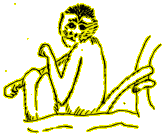 Known as the "organ-grinder's" monkey, these monkeys prefer to live in
the upper levels of the forest canopy. They are intelligent and agile, with a
"wise-old man" facial expression created by a wrinkled forehead and a
head of hair like a monk's hood. They are omnivores and eat a varied diet, consuming
fruits, seeds, flowers and their nectar. Capuchins travel in noisy troops. A
troop can range from 5 to over 30 monkeys who forage at various levels of the
forest. They hunt in the treetops and swoop down to the shrub, eating nearly all
animals they can catch: insects, snails, caterpillars, spiders and other small
animals. They also capture larger prey such as small rodents, opossums, baby
birds, lizards, and frogs. When capuchin monkeys lap up the nectar from flowers,
the fur surrounding their hairy faces gets covered in yellow pollen. By carrying
the pollen through the forest, they may assist in the pollination of some trees
to a greater extent than scientists have previously realized.
Known as the "organ-grinder's" monkey, these monkeys prefer to live in
the upper levels of the forest canopy. They are intelligent and agile, with a
"wise-old man" facial expression created by a wrinkled forehead and a
head of hair like a monk's hood. They are omnivores and eat a varied diet, consuming
fruits, seeds, flowers and their nectar. Capuchins travel in noisy troops. A
troop can range from 5 to over 30 monkeys who forage at various levels of the
forest. They hunt in the treetops and swoop down to the shrub, eating nearly all
animals they can catch: insects, snails, caterpillars, spiders and other small
animals. They also capture larger prey such as small rodents, opossums, baby
birds, lizards, and frogs. When capuchin monkeys lap up the nectar from flowers,
the fur surrounding their hairy faces gets covered in yellow pollen. By carrying
the pollen through the forest, they may assist in the pollination of some trees
to a greater extent than scientists have previously realized.
Howler Monkey

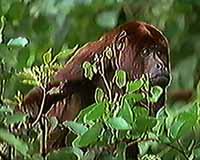 Howlers can be found all over the U. C. neotropics.
There are six species, two of which are considered endangered.
Howlers are large monkeys with prehensile tails and bearded faces. Fur colors
ranges from bright reddish to brown to black. The names come from their most
distinctive feature¡Xa ferocious, loud, and according people who have been
awakened from sleep by howlers, almost unearthly voice that echoes throughout
the rainforest at sunrise and sunset. Male howlers have specialized throat
structures that, like a megaphone, amplify their calls so they resonate for
nearly a mile through the rainforest. Howlers mark their territory: through
their calls, they are communicating the location of their ¡§turf¡¨ to other
troops, thus avoiding a face-to-face or troop-to-troop confrontation.
Howlers have a social structure: males are dominant
over females; troops generally consist of 3 adult males, 7-8 adult females and a
varying number of juveniles. Their prehensile tails and strong claws are
designed for gripping and leaping from branch to branch, so these leaf-eating,
tree-dwelling ¡§swingers¡¨ rarely have to come down to earth.
Howlers can be found all over the U. C. neotropics.
There are six species, two of which are considered endangered.
Howlers are large monkeys with prehensile tails and bearded faces. Fur colors
ranges from bright reddish to brown to black. The names come from their most
distinctive feature¡Xa ferocious, loud, and according people who have been
awakened from sleep by howlers, almost unearthly voice that echoes throughout
the rainforest at sunrise and sunset. Male howlers have specialized throat
structures that, like a megaphone, amplify their calls so they resonate for
nearly a mile through the rainforest. Howlers mark their territory: through
their calls, they are communicating the location of their ¡§turf¡¨ to other
troops, thus avoiding a face-to-face or troop-to-troop confrontation.
Howlers have a social structure: males are dominant
over females; troops generally consist of 3 adult males, 7-8 adult females and a
varying number of juveniles. Their prehensile tails and strong claws are
designed for gripping and leaping from branch to branch, so these leaf-eating,
tree-dwelling ¡§swingers¡¨ rarely have to come down to earth.
Tamandua
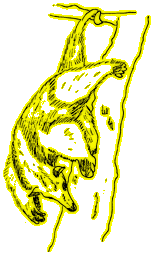
 This is a cat-sized anteater with short, coarse fur and a prehensile tail. It
spends nearly all its time in trees. South American tamanduas usually have a
uniformly honey colored coat; those from Central America have bold, two-toned
black and tan coats. Using its strong tail to grip the branch, the tamandua
breaks into the hard-walled outer protection of ant or termite nests with its
powerful fore-claws, and then catches ants and termites with its long sticky
tongue, licking up thousands during a meal. Although termites and ants form the
bulk of its diet, it will eat other insects (e.g. bees, beetles etc.) as well.
It does not eat all kinds of ants or termites! Army ants are too aggressive, and
can sting. Leaf-cutter ants are spiny, and difficult to swallow in its long,
toothless mouth. Such kinds of ants are usually avoided.
This is a cat-sized anteater with short, coarse fur and a prehensile tail. It
spends nearly all its time in trees. South American tamanduas usually have a
uniformly honey colored coat; those from Central America have bold, two-toned
black and tan coats. Using its strong tail to grip the branch, the tamandua
breaks into the hard-walled outer protection of ant or termite nests with its
powerful fore-claws, and then catches ants and termites with its long sticky
tongue, licking up thousands during a meal. Although termites and ants form the
bulk of its diet, it will eat other insects (e.g. bees, beetles etc.) as well.
It does not eat all kinds of ants or termites! Army ants are too aggressive, and
can sting. Leaf-cutter ants are spiny, and difficult to swallow in its long,
toothless mouth. Such kinds of ants are usually avoided.
Azteca ants are a favorite prey, but when thousands of
ants start pouring from the nest and onto the anteater, biting with their tiny
jaws, the anteater will usually retreat. Thus, the ant nest is rarely completely
destroyed.
Fruit Bat
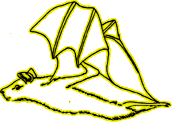
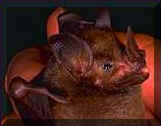 Many different kinds of fruit bats live in the Amazon. Some prefer to live only
in the upper canopy. As their name implies, fruit bats feed on flowers and
fruits. They have large eyes and sensitive noses and use both sight and smell to
locate fruit. Fruit bats have small, weak teeth and long, bristly tongues. As
the bat probes the flower for nectar, it collects pollen on its furry head and
neck. It then carries the pollen to other flowers.
Many tropical trees rely on bats for successful pollination of their flowers.
Whereas trees pollinated by birds often produce red flowers to attract the
birds, those that rely on bat-pollinators produce large amounts of nectar and
pollen and often tend to have flowers that are drab, bloom at night, or have a
fetid smell. Fruit bats eat the fruit of cecropia and other trees
and are essential seed dispersers. The seeds pass through their digestive tracts
and are thus widely scattered throughout the forest.
Scientists have observed that most bats spend only a few seconds or so at each
nectar and pollen-rich clump of flowers. This may be because tree snakes (like
the emerald tree boa) or other nocturnal predators often wait in hiding near
blooming flower clusters.
Many different kinds of fruit bats live in the Amazon. Some prefer to live only
in the upper canopy. As their name implies, fruit bats feed on flowers and
fruits. They have large eyes and sensitive noses and use both sight and smell to
locate fruit. Fruit bats have small, weak teeth and long, bristly tongues. As
the bat probes the flower for nectar, it collects pollen on its furry head and
neck. It then carries the pollen to other flowers.
Many tropical trees rely on bats for successful pollination of their flowers.
Whereas trees pollinated by birds often produce red flowers to attract the
birds, those that rely on bat-pollinators produce large amounts of nectar and
pollen and often tend to have flowers that are drab, bloom at night, or have a
fetid smell. Fruit bats eat the fruit of cecropia and other trees
and are essential seed dispersers. The seeds pass through their digestive tracts
and are thus widely scattered throughout the forest.
Scientists have observed that most bats spend only a few seconds or so at each
nectar and pollen-rich clump of flowers. This may be because tree snakes (like
the emerald tree boa) or other nocturnal predators often wait in hiding near
blooming flower clusters.